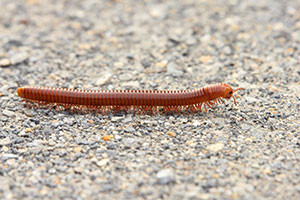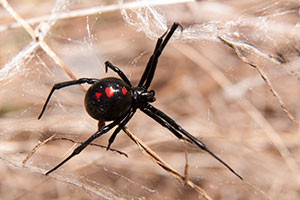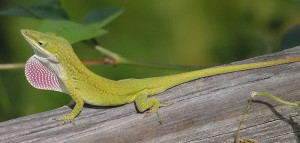 Crawling all over the Everglades’ trees and floors are reptiles. More than 50 distinct kinds of reptiles live in the Park. The Park’s most well-known reptiles are, of course, the American alligator and the American crocodile, but there’s plenty of other scaly creatures running around, including the very tiny green anole (anolis carolinensis).
Crawling all over the Everglades’ trees and floors are reptiles. More than 50 distinct kinds of reptiles live in the Park. The Park’s most well-known reptiles are, of course, the American alligator and the American crocodile, but there’s plenty of other scaly creatures running around, including the very tiny green anole (anolis carolinensis).
The green anole is native to Florida. In fact, this anole is the only native anole in the United States. The anole is found in warm, humid climate, so mostly in southeast United States. This tiny lizard can change from brown to green as it blends and camouflages to its surroundings. They can change colors in mere seconds. They are known to change colors when under stress, also. They have a red throat pouch, as well. When the male anoles, lift their heads and make their red pouches protrude, they are either attracting a mate or marking their territory to other male anoles.
These green anoles only grow to a maximum length of 8 inches. Both male and females have oversized toes for traction; they have adhesive toe paid and claws, which also make climbing easy. They have a long snout, slender body, and have a lightly patterned coloration on their backs and tails. They are known to aggressively defend their territories.
Their mating season is between April and July. The females can lay one egg each week throughout the four month mating season. It takes the eggs 35-40 days to hatch. Baby anoles have to defend themselves, after hatching. The green anoles eat insects, spiders, and moths; they swallow their prey whole. The anole’s lifespan is around 5 years.
Green anoles can be found on trees and all habitats around the Everglades. They are also a common house pet.
Green anoles have been studied a lot to help with scientific research to help understand other behaviors in animals, as well as neurological disorders and drug delivery systems and biochemical pathways in regard to human illnesses.
Want to spot a green anole in the wild? You may get your chance on an Everglades airboat tour. Come out today and experience the magic of the Everglades with Captain Mitch’s Airboat Tours. To book an airboat ride, click here or call 800-368-0065.
Photo courtesy: wikimedia
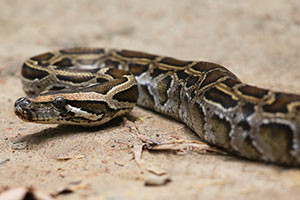 One of the biggest threats to a balanced ecosystem in the Everglades is the Burmese pythons. These snakes are an invasive species in the wetland. The python happens to love the Everglades, but this wetland cannot handle its presence. Pythons prey on almost anything in their path, and have been known to cause a large depletion in the rabbit, opossum, wading birds, racoons and other small populations population in the area. Its only predators are the American alligator and the Florida panther. However, these pythons can put up a fight and a recent video take by someone in the Everglades showed an alligator losing a fight with a python in water.
One of the biggest threats to a balanced ecosystem in the Everglades is the Burmese pythons. These snakes are an invasive species in the wetland. The python happens to love the Everglades, but this wetland cannot handle its presence. Pythons prey on almost anything in their path, and have been known to cause a large depletion in the rabbit, opossum, wading birds, racoons and other small populations population in the area. Its only predators are the American alligator and the Florida panther. However, these pythons can put up a fight and a recent video take by someone in the Everglades showed an alligator losing a fight with a python in water.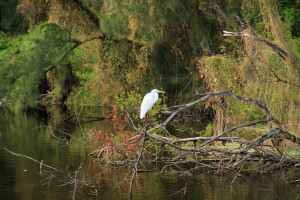 It’s officially the dry season in the Everglades and Florida, which is the best time to head down to the area to view an array of different wildlife species. During this time of year, the good weather combined with low water levels creates the perfect conditions and environment for animals and birds to congregate near bodies of water.
It’s officially the dry season in the Everglades and Florida, which is the best time to head down to the area to view an array of different wildlife species. During this time of year, the good weather combined with low water levels creates the perfect conditions and environment for animals and birds to congregate near bodies of water. The Burmese python is well-known to be an invasive species in the Florida Everglades; however, there seems to be another major invasive reptile in the wetland: The Nile crocodile. Yes, the Everglades are full of crocodiles, but they’re native to America. These Nile crocodiles come from Africa. But, how did these crocs make their way across the Atlantic Ocean? And, how they end up swimming around the Everglades? That is the big question.
The Burmese python is well-known to be an invasive species in the Florida Everglades; however, there seems to be another major invasive reptile in the wetland: The Nile crocodile. Yes, the Everglades are full of crocodiles, but they’re native to America. These Nile crocodiles come from Africa. But, how did these crocs make their way across the Atlantic Ocean? And, how they end up swimming around the Everglades? That is the big question.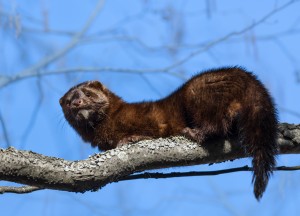 The Everglades is home to the Everglades Mink, hence the name! This small member of the weasel family is one of three types of minks found in Florida. The Everglades Mink happens to be the only one that lives in south Florida. They are semi-aquatic, carnivorous and also related to otters, ferrets, badgers, and martens.
The Everglades is home to the Everglades Mink, hence the name! This small member of the weasel family is one of three types of minks found in Florida. The Everglades Mink happens to be the only one that lives in south Florida. They are semi-aquatic, carnivorous and also related to otters, ferrets, badgers, and martens. Contrary to popular belief, coyotes are not limited to southwestern states. In fact, coyotes exist throughout the majority of Florida, and the Everglades is no exception. Coyotes are considered a noninvasive species since they found their way to Florida without any human intervention. And the population of coyotes in Florida has steadily increased over the past 15 years. Everglades coyotes are primarily found in marshy habitats otherwise known as marl prairies. These wild dogs share terrain with all sorts of animals from marsh rabbits to armadillos.
Contrary to popular belief, coyotes are not limited to southwestern states. In fact, coyotes exist throughout the majority of Florida, and the Everglades is no exception. Coyotes are considered a noninvasive species since they found their way to Florida without any human intervention. And the population of coyotes in Florida has steadily increased over the past 15 years. Everglades coyotes are primarily found in marshy habitats otherwise known as marl prairies. These wild dogs share terrain with all sorts of animals from marsh rabbits to armadillos. If you see short-finned pilot whales in the Everglades, your first thought is probably how majestic and beautiful they look. But your second realization should be how much danger they might be in. A couple of years ago, dozens of pilot whales died in the Everglades.
If you see short-finned pilot whales in the Everglades, your first thought is probably how majestic and beautiful they look. But your second realization should be how much danger they might be in. A couple of years ago, dozens of pilot whales died in the Everglades.